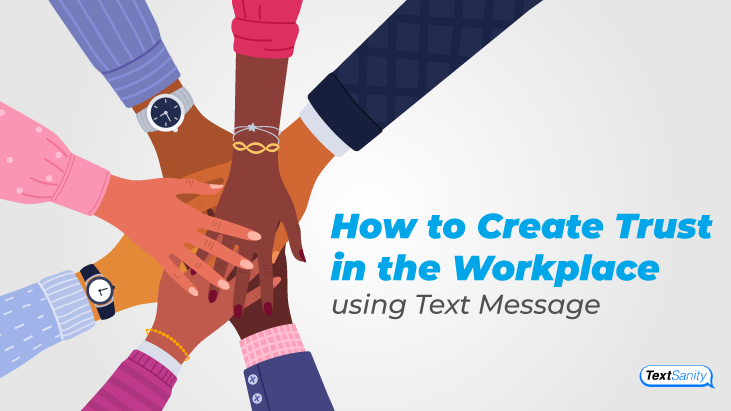5 Easy Ways to Create Trust Using Text Message in the Workplace
Learning how to create trust is very important in today’s work environment. If people don’t trust you and your brand, you could fail epically. You don’t want that. Instead, create a workplace culture where each employee feels comfortable expressing their opinions and needs. Developing an effective employee communication strategy through SMS messaging, a positive company culture, and top-down workplace communication channels will not only create a more inspirational and encouraging employee experience, but it’s also the key to your business success. Think about it this way: the fewer people speak up, the less creativity you cultivate. When more people speak up, the more creativity you cultivate. That’s why employee communication and employee engagement are key: More people equal more ideas.
1. Let Anonymity Thrive at First
The easiest way to begin to cultivate a culture of trust is to allow anonymity, especially if the previous work culture stunted trust. Anonymity allows people to feel more comfortable sharing their opinions and ideas. One of the easiest ways to allow anonymous sharing in the workplace is through collaborating with your human resources department for text marketing keyword campaigns.
Keyword campaigns are useful for both external business communication and internal communication. Furthermore, implementing modified internal business keyword campaigns for anonymous employee communication methods boosts participation. Simply send out a single-message keyword campaign, and you’ve implemented the first of many effective communication strategies.

The communicators can answer anonymously at their leisure straight from their mobile devices. No opting-in. No linking phone numbers to names. Using the right collaboration tools, this mass real-time communication plan is the first step towards your company’s success. Replies received go straight to an aggregated excel sheet, where you can measure metrics such as employee satisfaction, employee morale, and employee communication needs. And the happier your employees become, the higher your employee retention.
2. Implement Suggestions
Obviously, anonymity is a good place to start. However, in order to continue to create a culture of trust, employees need to eventually feel comfortable sharing their opinions and ideas through face-to-face communication. This only happens when team members trust that their feedback is taken seriously. Meaning that suggestions from single-message keyword communication programs are considered and implemented.
Since the replies from single-message keyword campaigns are aggregated into an excel sheet you gain the advantage of looking over all the feedback in one fell swoop. Take the suggestions in stride. After all, trust isn’t cultivated all at once.

First, look at the answers you’ve received. Second, consider how the suggestions can be implemented. Third, set up a text message company news feed to remind or notify both in-office and remote employees of new workplace policies and procedures. And let them know that these changes are happening because of their feedback!
3. Facilitate Small Group Sharing to Create Trust
After continual implementation of employee suggestions from this mass form of two-way communication, move forward with small group sharing. First, separate co-workers into small groups. Second, choose a topic for the group to concentrate on. Third, send out a survey to the group using a multiple-message keyword campaign. Fourth, aggregate answers. And finally, allow employees time and space to discuss the topic and the answers to the survey.
Surveys ask a few questions about a given topic. Since each person answers anonymously, they aren’t under any pressure to provide a “correct” or “right” answer. This allows people to get their real opinions out and provides a great place to start when facilitating discussions.

Take note of each group’s recommendations. Consider them just as you did with single-message keyword campaigns. Perhaps some of the feedback you receive causes you to stop implementing one thing and instead implement another. Or the feedback may confirm that you’re on the right track with implementation.
4. Aid One-On-One Conversations
The final stage of creating and maintaining a culture of trust is for employees to feel comfortable expressing themselves directly to supervisors. However, this won’t happen overnight. It’s going to take time for employees to feel comfortable with the idea.
Most important for employers is ensuring that single-message keyword campaigns and small group sharing using multiple-message keyword campaign surveys went well and the suggestions implemented. At this final stage, supervisors make the process of sharing one-on-one easier by facilitating the conversation over text message with the supervisor using the text marketing inbox.

This privacy allows a conversation to take place in a less intimidating situation. The employee communicates on their own time in their own space and so does the supervisor. This also preserves workplace productivity. The conversation, facilitated with a text marketing inbox, may take place over a matter of hours, or throughout a single day.
5. Promote Employee-Supervisor Interaction Face-to-Face
Once you’ve reached a point with employees where they trust you enough to have a one-on-one conversation with you over text marketing inbox, and you’ve shown them you’ve taken their thoughts and opinions seriously, it’s time to move on to in-person communication.
This is perhaps the easiest step in creating trust in the workplace. Or should be if the previous steps have been implemented well. In the end, you want your employees to trust you enough to come directly to you with their suggestions. You want and need that personal interaction in the workplace.

Creativity and suggestions create a better business for you and a better place to work for employees. Hopefully, the positivity of your interactions will even lead them to text message you. Although these messages are professional, their very existence speaks to the trust you’ve created in the workplace. They are willing to text message you just as they would a friend, albeit about a business matter.
Use Text Marketing to Create Trust in the Workplace
Obviously, you won’t be able to implement all the suggestions at once. It will take some time to change workplace culture and practices. And that’s okay! As long as employees see supervisors trying to enact change on their behalf, they’ll begin to build trust.
The text marketing tools: single-message keyword campaigns, surveys using multiple-message keyword campaigns, and the text marketing inbox all contribute to creating a culture of trust. Most important, however, is ensuring employees feel heard and understood. These tools simply contribute to that aim.


